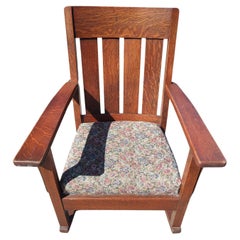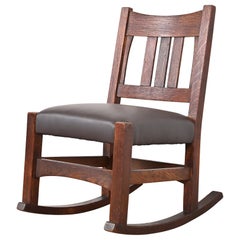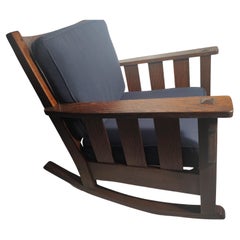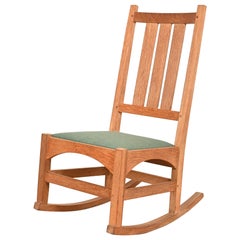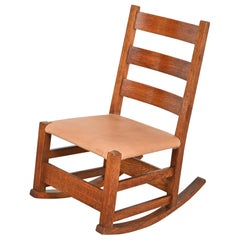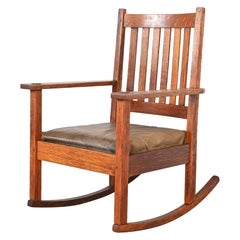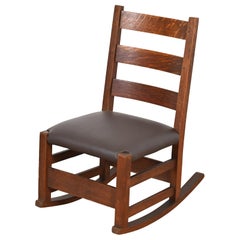Stickley Rocking Chairs
Vintage 1910s American Arts and Crafts Rocking Chairs
Fabric, Oak
Early 20th Century American Arts and Crafts Rocking Chairs
Leather, Oak
Vintage 1910s American Arts and Crafts Rocking Chairs
Fabric, Oak
Early 20th Century American Arts and Crafts Rocking Chairs
Leather, Oak
Early 20th Century American Arts and Crafts Rocking Chairs
Upholstery, Oak
Early 20th Century American Arts and Crafts Rocking Chairs
Leather, Oak
Early 20th Century American Arts and Crafts Rocking Chairs
Leather, Oak
Early 20th Century American Arts and Crafts Rocking Chairs
Leather, Oak
Early 20th Century American Arts and Crafts Rocking Chairs
Leather, Oak
Early 20th Century American Arts and Crafts Rocking Chairs
Upholstery, Rush
Antique Early 1900s American Arts and Crafts Rocking Chairs
Oak
Early 20th Century American Arts and Crafts Rocking Chairs
Faux Leather, Oak
21st Century and Contemporary American Arts and Crafts Rocking Chairs
Leather, Oak
1990s American Arts and Crafts Rocking Chairs
Upholstery, Oak
Early 20th Century American Arts and Crafts Rocking Chairs
Leather, Wool, Cotton, Upholstery, Oak
Early 20th Century American Arts and Crafts Rocking Chairs
Leather, Oak, Upholstery, Cotton
Early 20th Century American Arts and Crafts Rocking Chairs
Leather, Oak
Early 20th Century American Arts and Crafts Rocking Chairs
Leather, Oak
Vintage 1910s American Arts and Crafts Rocking Chairs
Brass
Antique Late 19th Century American American Craftsman Rocking Chairs
Wood, Oak
Early 20th Century American Arts and Crafts Rocking Chairs
Leather, Cotton, Oak
Vintage 1910s American Arts and Crafts Rocking Chairs
Canvas, Oak
Early 20th Century American American Colonial Rocking Chairs
Upholstery, Chestnut
Early 20th Century American Arts and Crafts Rocking Chairs
Leather, Cotton, Upholstery, Oak
Early 20th Century American Arts and Crafts Rocking Chairs
Leather, Upholstery, Oak
Early 20th Century American Arts and Crafts Rocking Chairs
Leather, Upholstery, Oak
20th Century American Mid-Century Modern Rocking Chairs
Chestnut
Early 20th Century American Arts and Crafts Rocking Chairs
Leather, Cotton, Upholstery, Oak
Early 20th Century American Arts and Crafts Rocking Chairs
Leather, Wool, Cotton, Oak
Early 20th Century American Arts and Crafts Chairs
Leather, Oak
Early 20th Century American Rocking Chairs
Antique Early 1900s Rocking Chairs
Wood
Vintage 1940s American Armchairs
Early 20th Century American Arts and Crafts Rocking Chairs
Oak
Antique Early 1900s American Mid-Century Modern Rocking Chairs
Leather
Early 20th Century American Arts and Crafts Rocking Chairs
Upholstery, Oak
Early 20th Century American Arts and Crafts Rocking Chairs
Oak
Early 20th Century American Arts and Crafts Rocking Chairs
Oak
Early 20th Century American Arts and Crafts Rocking Chairs
Leather, Oak
Early 20th Century American Arts and Crafts Rocking Chairs
Leather, Oak
Early 20th Century American Arts and Crafts Rocking Chairs
Brass
Early 20th Century American Arts and Crafts Rocking Chairs
Leather, Oak
Early 20th Century American Arts and Crafts Rocking Chairs
Wood, Oak, Upholstery
Early 20th Century American Arts and Crafts Rocking Chairs
Leather, Oak
20th Century American Arts and Crafts Rocking Chairs
Upholstery, Oak
Early 20th Century American Arts and Crafts Rocking Chairs
Leather, Oak
21st Century and Contemporary American Arts and Crafts Rocking Chairs
Leather, Oak
20th Century American Arts and Crafts Rocking Chairs
Upholstery, Oak
Early 20th Century American Arts and Crafts Rocking Chairs
Oak
21st Century and Contemporary American Arts and Crafts Rocking Chairs
Leather, Cherry
21st Century and Contemporary American Arts and Crafts Rocking Chairs
Leather, Cherry
21st Century and Contemporary American Arts and Crafts Rocking Chairs
Leather, Cherry
Early 20th Century American Arts and Crafts Rocking Chairs
Leather, Oak
20th Century American Rocking Chairs
Wood, Leather
Early 2000s American Mission Rocking Chairs
Cherry
Early 20th Century American Arts and Crafts Rocking Chairs
Oak
Early 20th Century Arts and Crafts Rocking Chairs
Oak
20th Century American Arts and Crafts Rocking Chairs
Upholstery, Oak
Early 20th Century American Arts and Crafts Rocking Chairs
Wood, Oak, Leather
Early 20th Century American Mission Rocking Chairs
Upholstery, Oak
- 1
Stickley Rocking Chairs For Sale on 1stDibs
How Much are Stickley Rocking Chairs?
Finding the Right Rocking-chairs for You
The phrase “rocking chair” didn’t find its way into the dictionary until the mid-18th century. While most of the sitting furniture that we use in our homes originated in either England or France, the iconic rocking chair is a quintessentially American piece of furniture.
A Philadelphia cabinetmaker’s bill for a proto-rocking chair issued in 1742, which identified the seat as a “Nurse Chair with rockers,” is the earliest surviving evidence of this design’s humble beginnings. The nurse chair was a low side chair intended for nursing women, so giving it a soothing rocking motion made sense. Rocking chairs, which saw a curved slat affixed to the chairs’ feet so that they could be literally rocked, quickly gained popularity across the United States, garnering a reputation as a seat that everyone could love. They offered casual comfort without the expensive fabrics and upholstery that put armchairs out of many families’ budgets.
Rocking chairs are unique in that they don’t just offer a place to rest — they offer an opportunity to reminisce. The presence of one of these classic pieces stirs up our penchant for nostalgia and has the power to transform a space. They easily introduce a simple country feel to the city or bring the peaceful rhythm of a porch swing into a sheltered sunroom. Although craftsmen took to painting and stenciling varieties of the chairs that emerged in New England during the 19th century, the most traditional rocking chairs are generally unadorned seats constructed with time-tested materials like wood and metal. As such, a minimalist vintage rocking chair can be ushered into any corner of your home without significantly disrupting your existing decor scheme or the room’s color palette.
In the decades since the first rocker, top designers have made the piece their own. Viennese chair maker Michael Thonet produced a series of rockers in the middle of the 19th century in which the different curved steam-bent wood parts were integrated into fluid, sinuous wholes. Mid-century modernists Charles and Ray Eames added wooden rockers to their famous plastic shell armchair, while Danish designer Frank Reenskaug opted for teak and polished beech, introducing pops of color with small cushions (a precursor to the bold works that would follow in the 1970s and 1980s).
No matter your personal style, let 1stDibs pair you with your perfect seat. Deck out your porch, patio or parlor — browse the vintage, new and antique rocking chairs in our vast collection today.
- Are Stickley chairs marked?1 Answer1stDibs ExpertMarch 22, 2022Yes, Stickley chairs are usually marked. However, the markings changed over time. Early pieces have the brand burned onto the frame. Later pieces may show the name on a paper label, decal, metal plate or carved medallion. On 1stDibs, find a variety of Stickley furniture.
- 1stDibs ExpertAugust 15, 2024To tell if a chair is a Stickley, look for the maker's mark, usually found underneath the seat. Depending on the age of the chair, it may appear on a paper or metal label, be burned into the frame or be stamped on it with ink. Stickley used a number of different markings over the years, but has images of most of its historic marks available for viewing on the maker's official website. You can compare the markings on your chair to those found in this reference. If you need assistance, enlist the help of a certified appraiser or knowledgeable antique dealer. On 1stDibs, explore a collection of Stickley chairs.
- 1stDibs ExpertNovember 26, 2024To identify a Stickley chair, look under the seat and on the legs for a paper label or metal tag. Stickley has modified its markings over time, so you can use these to determine the approximate age of your chair as well as to figure out if it is a Stickley. You can find image guides to interpreting Stickley maker’s marks on trusted online resources. Alternatively, you can have a certified appraiser or experienced antique dealer perform the identification process for you. On 1stDibs, find a selection of Stickley chairs.
- 1stDibs ExpertAugust 26, 2024The difference between a Morris chair and a Stickley chair comes down to origins and characteristics. A Morris chair gets its name from William Morris, one of the founders of the British company Morris, Marshall, Faulkner & Co. During the late 1860s, the company began producing the Morris chair, which has a reclining seat back and an intricately carved wood frame. This design spread to the U.S., where it was seen by Gustav Stickley. Drawing inspiration from it, Stickley produced the Stickley chair in 1904. Like the Morris chair, the piece has a reclining back but a simpler slatted frame that aligns with the American Arts and Crafts design style. Due to its origins, some people call the Stickley chair the Stickley Morris chair or the Mission Morris chair. Explore a collection of Stickley chairs and Morris chairs on 1stDibs.
- 1stDibs ExpertMarch 22, 2022To tell if a Morris chair is a Stickley, look for the furniture designer's mark. Often, Gustav Stickley marked his pieces with a compass logo, his signature and the phrase "Als ik kan." The phrase roughly means "to the best of my ability." On 1stDibs, shop a collection of expertly vetted Stickley chairs.
- 1stDibs ExpertApril 5, 2022A platform rocking chair is a rocking chair constructed to have the rockers on a fixed platform rather than the floor. You’ll find a collection of vintage and contemporary platform rocking chairs from some of the world’s top sellers on 1stDibs.
- 1stDibs ExpertApril 5, 2024What a rocking chair symbolizes is largely a matter of individual interpretation. Some people associate rocking chairs with comfort or relaxation. Because people often sit in the chairs to gently rock babies to sleep, the furniture may also represent parenthood or motherhood. On 1stDibs, explore a diverse assortment of rocking chairs.
- How old is the rocking chair?1 Answer1stDibs ExpertFebruary 27, 2024The rocking chair is more than 275 years old. Early models date back to around 1725 and were made by outfitting Windsor chairs with skates. By 1787, rocking chairs were common enough for the word to be added to the English dictionary. On 1stDibs, shop a diverse assortment of rocking chairs.
- What is a Windsor rocking chair?1 Answer1stDibs ExpertOctober 26, 2021A Windsor rocking chair is built for comfort and is usually manufactured in such a way that the seat’s spindles, along with the chair-back and legs, are pushed into holes that have been drilled. This sets this type of chair apart, as the standard construction of a chair sees that the back legs are continuous. The Windsor chair originated in the early 1700s in the English town of Windsor. As mentioned, their bentwood back frames are assembled with slender wooden spindles that are plugged into drill holes in the sculpted seat, which was usually made of elm and slightly sunken or dish-shaped for the sitter’s comfort. Shop a collection of antique and vintage Windsor rocking chairs from some of the world’s top dealers on 1stDibs.
- What is a Boston rocking chair?1 Answer1stDibs ExpertApril 5, 2022A Boston rocking chair is a wooden rocking chair with a decorative top panel and a seat and arms that curve down towards the front. Find an assortment of rocking chairs from some of the world’s top sellers on 1stDibs.
- 1stDibs ExpertAugust 16, 2019
A rocking chair helps soothe infants, children, and adults alike. The rocking and swaying movement helps create a meditative and lethargic state.
- 1stDibs ExpertApril 5, 2022To identify a Thonet rocking chair, look for the company name. You will normally find it stamped directly onto the underside of the seat, arms or legs. You can find a collection of expertly vetted Thonet rocking chairs on 1stDibs.
- 1stDibs ExpertAugust 16, 2019
A wooden rocking chair can be cleaned using a sponge, soap, and water. After, you should proceed to pat the rocking chair down with a cloth.
- 1stDibs ExpertApril 5, 2022To identify a Windsor rocking chair, enlist the help of a licensed furniture appraiser. Many convincing distressed reproductions exist due to their popularity and value. An experienced professional can accurately determine if yours is an authentic antique or a replica. Find a range of expertly vetted Windsor rocking chairs on 1stDibs.
- 1stDibs ExpertOctober 24, 2024To tell if your rocking chair is an antique, search the back, rockers and the underside of the seat for a label, stamp or other marking. If you locate one, conduct online research using trusted resources to learn about the maker. By finding out when the manufacturer produced chairs similar to yours, you may be able to determine if your chair is at least 100 years old, making it an antique. If you cannot find a maker's mark, consider contacting a certified appraiser or antique dealer and asking them to date your piece for you. Explore a range of antique rocking chairs on 1stDibs.
- 1stDibs ExpertOctober 12, 2021The cost of a wooden rocking chair varies depending on the type of wood used, its finish and craftsmanship. Also, the period that the rocking chair belongs to will define the price of the chair. An antique rocking chair might cost between $500 and $1,500 while a contemporary rocking chair may cost somewhere between $150 and $400. Find a variety of antique, vintage, and contemporary wooden rocking chairs on 1stDibs.
- 1stDibs ExpertAugust 8, 2024No, Benjamin Franklin did not invent the rocking chair. This common misconception is linked to an erroneous statement made in the book The Rocking Chair: An American Institution, published in 1921. In actuality, rocking chairs were created by English farmers early in the 18th century. Early American examples date back to around 1830. On 1stDibs, find a wide variety of rocking chairs.
- 1stDibs ExpertOctober 24, 2024To tell the age of an old rocking chair, search under the seat, the legs and the bottom of the rockers for a maker's marking. By researching the maker and learning about how the characteristics of its pieces evolved over the years, you can often get a rough idea of how old your rocking chair is. If you are unable to find a mark, your piece could be a newer handcrafted item or an antique, in which case it would be helpful to have a certified appraiser or knowledgeable antique dealer evaluate your piece. An expert can also assist you if you run into any difficulty dating your piece. Explore a variety of rocking chairs on 1stDibs.
